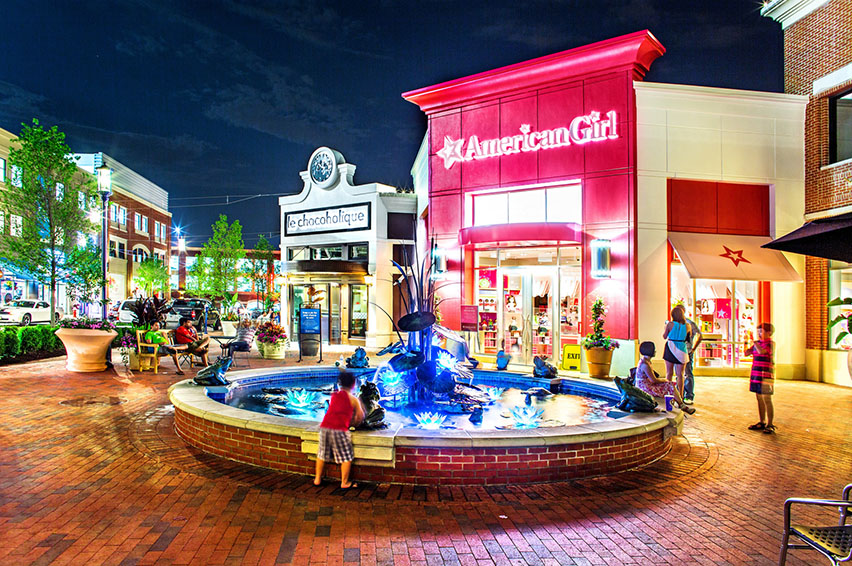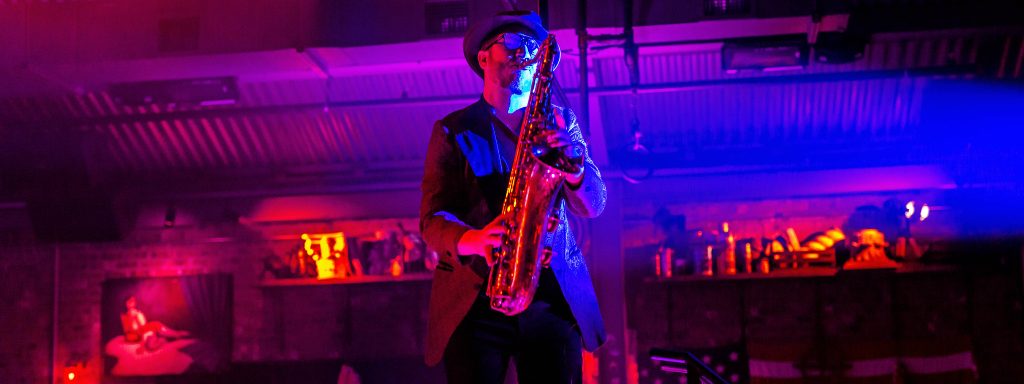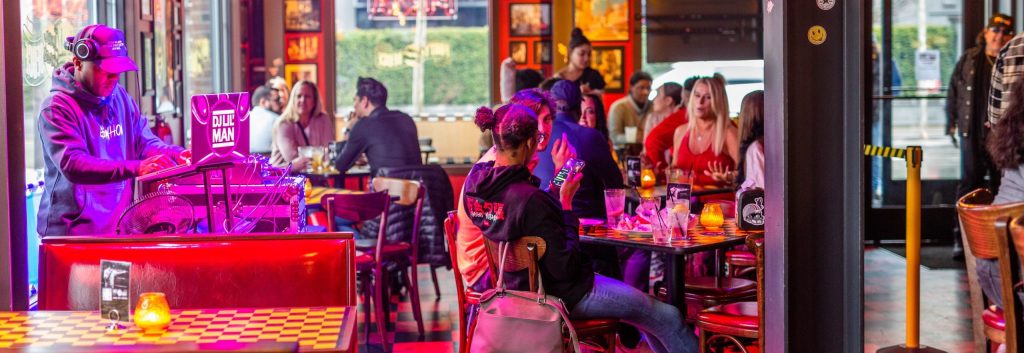By Yaromir Steiner
Read The Future of American Retail – Part 1
The internal forces that have buffeted the regional mall format range from changes in management style, to design and programming philosophy, and the influence of new technologies on retail behavior. From California to the Carolinas, and from the Midwest to the Southern Plains, forces within the industry continue to exert a profound influence on traditional regional malls:
Department store
There is no question that the impact of the regional mall is not what it once was. The slow drift away from the format is reflected in the changing role of the traditional department store. The single-use urban planning model and the abundance of affordable and available land that gave rise to the first shopping centers also created a set of circumstances where, during that growth period, department stores were run largely by financiers rather then by merchants. The result of that shift was significant. To a large extent, the focus moved to achieving short-term financial goals instead of long-term vision; maximizing space productivity rather than establishing a diverse and appealing mix of merchandise; and maintaining cheaper occupancy costs rather than focusing on the strategic positioning and protection of the brand.
Cheap land and single-zoning shopping centers meant that there was less of a need to “go vertical,” and as (in the hands of merchant owners) the suburban regional mall essentially became the new department store, the traditional downtown department stores became less relevant to suburban America. Today, the most successful department stores are those that are largely merchant-run and have maintained an aggressive, responsive, and consumer-focused posture.
A new Target audience
It is said that “nature abhors a vacuum.” Similarly, as traditional department stores began to fall out of favor, innovative newer models began to establish themselves. Retailers like Target, Kohl’s and JC Penney’s have moved forward by largely abandoning convention along with any last vestige of the old multistory urban model. Understanding that translating the traditional format to the suburbs was never a great fit, these innovators have abandoned long-held assumptions to embrace an entirely new approach. By creating something new – a vibrant, freestanding single-story destination with a strong consumer focus – this new generation of department stores has redefined the genre. Retailers like Target have re-embraced the merchant ethos, and committed themselves to providing customers what they want and what they need. Instead of trying to transplant an urban format to the suburbs, these new malls have created something entirely new; reinventing themselves and exerting a profound influence the retail development industry in the process. What makes these retailers effective is that they have shown the ability to evolve. And as retail development continues to move away from single-use zoning environments in the future, that evolution must continue if they wish to remain successful. In fact, Target is already doing this to some extent; tasking their special units team to adapt to unusual land use conditions.
The REIT stuff
Economic realities and marketplace priorities can be a double-edged sword. The emergence of the Real Estate Investment Trust (REIT) as an increasingly common ownership format has had a profound effect on the long-term success of regional malls. Similarly to the dynamic that has seen department stores adopt more of a short-term bottom-line perspective, more and more often decisions are being driven by financial considerations rather than by merchandising considerations. When financiers are making the kind of strategic decisions that should be made by merchants, the results can be predictably uninspired. While some owners and developers have kept their regional malls relevant by investing their capital thoughtfully and carefully monitoring the quality of their tenant mix, the general trend line is clear.
The value of most REITs is based on short-term metrics. The funds from operations (FFO), a figure REITs use to define the cash flow from their operations, and the value of the shareholders to a great extent determines the value of the REIT. Assuming, logically, that the market objective is to maximize the value of that REIT, then capital expenditures take on a whole new level of short-term importance. To maintain upkeep on the premises and maintenance on the property requires a steady flow of cash; the same funding source that was typically invested to encourage retailers to upgrade facilities or work with owners to upgrade their stores. The trend away from proportionate Common Area Maintenance (CAM) fees reimbursed by the retailer, to a fixed CAM has had consequences. Now, REITs are faced with what can seem like a conflict: the desire to cut costs and maximize short-term value, or cut some corners in maintenance and improvements and pocket whatever does not get spent. Subsequently, many centers experience a gradual long-term degradation of the quality of the grounds and the maintenance, and tenant allowances may suffer. The natural process of replacing/upgrading tenants that any successful mall must engage in requires capital expenditures. That money either comes from the REIT (which obviously diminishes cash available for distribution) or from the retailer (which may directly impact their renting capacity). In this counterproductive dynamic, the system is organized to minimize capital expenditures and maximize rent collection; rewarding decisions that may make sense on paper and still have negative long-term consequences.
To be fair, some REITs have a bit more flexibility and are able to let their stock price sag somewhat in the short-term, but many cannot afford that luxury. The best examples of successful contemporary retail and mixed-use developments are living proof that investing in the quality of the environment is critical, and that the failure to do so risks not only diminishing the strength of the emotional attachment that shoppers develop to a place, but also ultimately potentially giving up strategic position in the market. Easton Town Center in Columbus, Ohio; Bal Harbour Shops in Miami, Florida; NorthPark Center in Dallas, Texas; South Coast Plaza in Costa Mesa, California; and Somerset Collection in Troy, Michigan all offer vibrant and engaging environments and, ultimately, superior projects. It is not a coincidence that the ownership of those developments is not publicly traded; all of these projects are owned by groups or families who are experienced merchants in their own right.
A leisurely approach
The successful integration of increasingly dynamic leisure-time uses in retail and mixed-use environments has been one of the most profound evolutionary shifts within the industry, and has further clouded the future for the traditional regional mall format. From cinemas, bars, restaurants and comedy clubs, to spectacular sport-and-entertainment options, the commercial energy and mixed-use synergy that can be generated by incorporating leisure-time elements into traditional retail formats has opened both eyes and wallets. A powerful demonstration of the power of dense mixed-use environments to drive foot traffic and stimulate retail energy can be seen in a number of representative and dramatic examples around the country. It is not unheard of, for example, for a restaurant in a mixed-use town center to bring in significantly higher revenue compared to an identical restaurant across town in a single-use retail development serving the same demographic base.
Mixed-use designs and leisure-time elements must be thoughtfully conceived and skillfully executed to work well; it is not enough to simply graft a liner building or a short retail avenue to the side of a mall. Therein lies the difficulty for enclosed regional malls. Closed off and inward facing, they are not generally amenable to easy redevelopment or upgrade. When done right, however, the best mixed-use destinations use the power of the street grid and a rich urban fabric to capture the bustling energy of traditional urban centers.
While much of the long-term trajectory of regional malls can be traced via internal forces, influences from outside the retail development industry have also exerted unavoidable and (some would argue inevitable) cultural, behavioral, demographic and design pressures that are changing the ways that we perceive retail environments:
Zoned out
The gradual phasing out of zoning as the sole urban planning tool has opened up new realms of design and development possibility. People have begun to realize that applied literally, single-zoning development was creating an urbanistically orphaned America. The lack of true town centers and central community gathering places has taken a collective toll, and there is a growing and genuine appreciation for retail and mixed-use spaces that are more dense, organic and integrated into the space and places we use everyday. In this context, the sterility and relative remoteness of the stand-alone regional mall comes up short.
Walking the walk
When Americans are asked to name memorably great urban spaces that appeal to them, the vast majority of responses name places that were built in the first half of the 20th Century. In the ensuing decades, the population has gone from 200 million to 300 million, we have been to the moon, and yet in all that time, we have largely failed to create the kind of places that resonate. This is telling and troubling set of circumstances. There is a pent-up demand for walkable, mixed-use high-density community spaces; town centers, village squares, main streets and activated urban environments that recognize the need for something new and different and provide a built environment that supports experience and interaction. The success of thoughtfully designed residential components as an integral part of newer mixed-use developments has reinforced the notion that “live, work and play” design must be a large part of our retail strategy going forward.
Conservation nation
As our society continues to go green and prioritize healthy, environmentally sensitive lifestyle choices, higher-density projects and retail and mixed-use destinations that accommodate a car-free lifestyle will only continue to grow in popularity. Environmental considerations such as minimizing carbon footprints, reducing waste and participating in eco-conscious behaviors will continue to influence design and development decisions going forward. Efficiencies of space and resources and technological advances that facilitate a conservation-minded lifestyle are more practical in today’s denser mixed-use environments.
Online versus inline
The Internet has also played a significant role in changing the way traditional retail destinations are perceived. Beyond the direct competition or the raw sales numbers, the ability of the Internet and online shopping to impact the way that brick-and-mortar malls function and focus on the shopper’s experience has been profound. Retailers and developers alike are beginning to acknowledge that shopping can become an exploration; stores are turning to more guerilla retailing models and developers are abandoning the static monotony of the traditional regional mall setting in favor of more dynamic, flexible and experiential designs.
Commodities inevitably migrate to the internet and online shopping does allow for greater pricing comparison, and so it might be tempting to conclude that only specialty items that need to be tried and touched will remain the exclusive provenance of malls and retail destinations. But that conclusion would be wrong. Some common examples that illustrate this point clearly are no further away than the local bookstore or Starbucks. Starbucks coffee is available at a much reduced price for at-home consumption. Nonetheless, vast numbers of people go to their local coffee shop every day, because there is something about the place and the experience that appeals to them. Whether it is the barista, the smell of fresh-brewed coffee, or the warmth and conviviality of the space, there is a powerful attraction that cannot be replicated outside of Starbucks itself. Books can now be ordered and even read online, but browsing at the bookstore is still a popular diversion for many. Finally, perhaps the most dramatic example is the Apple Store. Despite Apple’s well-understood product line, their stores have some of the most successful sales-per-square-foot numbers, and that is directly attributable to the fact that customers enjoy the experience of visiting the store; talking, touching, playing and interacting in a way that they cannot do when ordering something online.
The leveraging of short supply chains and limited merchandise runs has worked well for retailers such as H&M, Zara, and Forever 21. The operational mechanics of these formats (the ability to go into production and get new items to the marketplace quickly and a reluctance to reorder) gives them the flexibility to design and update their lines much more frequently and creates a sense of retail “urgency.” The result is a retail model that, in some ways, short-circuits the most appealing elements of online shopping. Consumers are learning that almost every other week there will be a whole new set of merchandise and, more importantly, that if they want access to that merchandise, they will need to visit the store again…and again…and again!
Where do we go from here?
As evidenced by the example of the Apple Store, the interactive and experiential nature of shopping can provide something important that sterile retail venues or a clinical online experience cannot. Humans crave social engagement, respond to comfortable surroundings, and will always prefer to participate in eyeing, trying and buying when they are given the option to do so in a well-designed space.
So where does this insight leave us? More importantly, where will this take us? How do we integrate the idea of experience into our retail vision going forward? What is the retail landscape going to look like in five years; ten years; and beyond? With the dominance of regional malls no longer a certainty, and fresh new formats emerging as a force in the marketplace, the inevitable conclusion is that mixed-use town centers represent the future of American retail. Activated, dynamic new retail and mixed-use environments, together with the redeveloped or converted regional malls will likely be able to provide a more vibrant and viable spectrum of mixed-use options. Town-center-style projects, particularly those with a strong leisure time component, do more than just accommodate these live, work, shop, play and entertain environments; they actively inspire them. Communities want, need, and love their retail and mixed-use spaces, and it is up to developers to deliver them.
While Power Centers and Big Box projects will continue to have a niche and strong grocery-anchored community centers will continue to perform, opportunities for mixed-use projects at the regional level will increase as a significant portion of existing mall assets will likely need to be rethought or remade. Just as the death of a large tree in the Amazon rain forest opens up a valuable patch of sunlight for fast-growing seedlings, the demise of some regional malls in the face of challenging economic circumstances will continue to create gaps in the development canopy. The challenge for experienced developers is to demonstrate sufficient insight, innovation and redevelopment savvy to take full advantage of those opportunities and create a new generation of mixed-use projects growing toward that patch of light.






